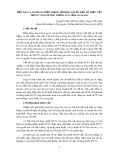
REVIEW Open Access
Systemic risks of genetically modified crops: the
need for new approaches to risk assessment
Hartmut Meyer
Abstract
Purpose: Since more than 25 years, public dialogues, expert consultations and scientific publications have
concluded that a comprehensive assessment of the implications of genetic engineering in agriculture and food
production needs to include health, environmental, social and economical aspects, but only very few legal
frameworks allow to assess the two latter aspects. This article aims to explain the divergence between societal
debate and biosafety legislation and presents approaches to bring both together.
Main features: The article reviews the development of biosafety regulations in the USA and the EU, focussing on
diverging concepts applied for assessing the risks of genetically modified organisms (GMOs).
Results: The dominant environmental risk assessment methodology has been developed to answer basic
questions to enable expedient decision making. As a first step, methodologies that take into account complex
environmental and landscape aspects should be applied. Expanding the scope of risk assessment, more holistic
concepts have been developed, for example the Organisation for Econonomic Co-operation and Development
(OECD) concept of systemic risks which includes socio-economic aspects. International bodies as the OECD, the
Convention on Biological Diversity (CBD) and the European Union (EU) have developed the Strategic
Environmental Assessment (SEA) as an instrument that includes the additional aspects of risk assessment as
demanded by many stakeholders. Interestingly, there had been no attempts yet to link the existing frameworks of
GMO risk assessment and SEA.
Conclusions: It is recommended to adapt current models of SEA to assess the systemic risks of GMOs. It is also
suggested to revise the EU GMO legislation to promote the inclusion of SEA elements.
Genetic engineering in agriculture: impacts and
restraints
The first genetically modified organisms (GMO) deregu-
lated and commercialised was the Flavr Savr tomato in
1994 in the USA, which did not prove to be commer-
cially viable. US genetically modified (GM) agriculture
actually started with Bt cotton planting in 1995, but it
only was the introduction of Roundup Ready soybeans
in 1996, being exported worldwide as basic ingredient
for the feed and food industry that initiated the world-
wide public debate on the use of GM crops. Meanwhile,
James reports that 15 countries grow more than 50,000
ha of GM crops each with a sum of 133.9 million hec-
tares [1]. According to FoEI–pointing to the fact that
the data presented by James are mostly based on
personal communic1ations by representatives of the bio-
technology industry, which also funds his work–this
area equates to 9.2% of the arable land worldwide [2].
Ninety-two percent of this area is located in five coun-
tries (USA, Brazil, Argentina, India, Canada). GM crop
agriculture relies on five plant species (soybean, maize,
canola, sugar beet and cotton) predominately producing
animal feed, ethanol and fibres in high-input farming
systems. Based on the data provided by James, it can be
concluded that GM food products mainly comprise
sugar, high-fructose corn syrup, soy protein, lecithin or
different oils [1]. Some GM maize varieties can be used
for direct consumption as, for example, in South Africa.
In the USA, some GM papaya is marketed. The range of
new properties used in GM crop agriculture is essen-
tially limited to two features: resistance against the her-
bicides glyphosate and glufosinate and production of
Correspondence: hmeyer@ensser.org
Federation of German Scientists (Vereinigung Deutscher Wissenschaftler,
VDW), In den Steinäckern 13, Braunschweig, 38116, Germany
Meyer Environmental Sciences Europe 2011, 23:7
http://www.enveurope.com/content/23/1/7
© 2011 Meyer; licensee Springer. This is an Open Access article distributed under the terms of the Creative Commons Attribution
License (http://creativecommons.org/licenses/by/2.0), which permits unrestricted use, distribution, and reproduction in any medium,
provided the original work is properly cited.

Bacillus thuringiensis (Bt) endotoxins that are used to
kill specific lepidoptera and coleoptera larvae (Table 1).
The main bottleneck for developing a higher variety of
commercially viable products seems to be the limited
potential of the technology itself. Complex characteris-
tics of plants as drought or saline resistance are based
on reactions of the plant organism at several, including
but not only the genetic level. Many–still unknown–
genes may play a role in the response to environmental
condition. The application of genetic engineering alone
might not lead to the improvement of such complex
traits [3-5]. Only GM plants possessing genes–which are
supposed to work in isolation from the plant’smetabo-
lism, as the herbicide resistance and Bt genes–are used
commercially. Additionally, two GM plant types posses-
sing pathogen-resistant genes which are supposed to
interact with an invading organism could be developed
into a commercial product: GM virus-resistant papaya
and squash grown on 2,000 ha each in the USA [6].
Until the end of 2004–which should leave enough time
for the development of commercial seed until 2009–the
U.S. authorities approved 877 field trials with plants that
were supposed to be virus resistant (988 until the end of
2009). Experiments with GM plants that were supposed
to be resistant against fungi did not result in any com-
mercial product yet, 622 field trials were approved in
the USA until the end of 2004 (854 until the end of
2009). The main blocks to market fungi-resistant GM
plants are the lack of deeper understanding of the mole-
cular plant-fungi interactions and the unsatisfactory
levels of resistance [7,8].
Stein and Rodríguez-Cerezo predict that a turning
point has been reached in the limited commercialisa-
tion of GM traits [9]. The authors estimate that in
2015 the number of traits in farmers’fields might
quadruple to 120, amongst them 17 soy traits (12 her-
bicide resistant, three altered oil composition, two pest
resistant) or 15 rice traits (six insect resistant, four
pest resistant, three herbicide resistant, two b-carotene).
This development would mainly increase the number of
traits mentioned above to 114. Only six traits aim at
influencing more complex characteristics as drought
resistance in maize while they still rely on single gene
alterations.
Table 1 Overview on deregulated and cultivated GM traits in the USA 1992-2009
Phenotype Plant species Number of
deregulated traits
a
Transgenic species in
cultivation
b
Herbicide tolerance 48
Glyphosate Canola, cotton, maize, soy,
sugar beet
15 Yes
Glufosinate Canola, cotton, maize, rice, soy,
sugar beet
27 Yes, not all species
Others Cotton, flax, maize, soy 6 Yes, not all species
Insect resistance 41
Corn borer Maize 26 Yes
Corn root worm Maize 3 Yes
Colorado beetle Potato 11 No
Other Tomato 1 No
Altered fruit ripening 40
Flavr Savr Tomato 33 No
Other Tomato 7 No
Virus resistance 12
Papaya ringspot virus Papaya 3 Yes
Cucumber mosaic virus, zucchini yellow mosaic virus,
watermelon mosaic virus 2
Squash 2 Yes
potato leaf roll virus, potato virus Y Potato 6 No
Plum pox virus Plum 1 No
Male sterility Cichoria, canola, maize 8 No
Altered oil composition Canola, soy 5 No
Higher lysin content Maize 1 No
Lower nicotine content Tobacco 1 No
a
http://www.aphis.usda.gov/biotechnology/not_reg.html, accessed 30 April 2010;
b
[1,6].
Source: own compilation.
Meyer Environmental Sciences Europe 2011, 23:7
http://www.enveurope.com/content/23/1/7
Page 2 of 11

Development of regulatory biosafety frameworks
Asilomar conference
It was U.S. scientists working in the fields of cancer
research and molecular biology being concerned about
the potential health risks of their work who started the
scientific debate on the pros and cons of GMOs [10].
The participants of the 1973 Gordon Conference on
Nucleic Acids drafted a resolution, which warned about
the potential health risks of hybrid DNA molecules and
called successfully upon the National Institutes for
Health (NIH) to develop safety guidelines [11]. An inter-
national conference to support the development of
safety standards was announced and even moratoria on
certain types of experiments suggested [12]. In spring
1975, participants of the Asilomar Conference recog-
nised that more than health problems might arise from
the industrial, medical and agricultural application of
genetic engineering, but they restricted their debates on
this risk issue. While the conference concluded that
mechanisms of self-control and voluntary guidelines
should be the basis for the development of the technol-
ogy, calls for a stricter and legally binding governmental
oversight were launched during the emerging public
debate in cities as Cambridge, Massachusetts, harbour-
ing major research institutions [12,13]. Envisaging a
growing unease of the public, prominent molecular biol-
ogists soon questioned the value of the early risk debate
[14-16].
Emerging biosafety systems in the USA
When Cohen reported that his research enables scien-
tists to cross the species barriers, suggesting the inven-
tion or creation of new species, U.S. politicians started,
soon after, to draft regulations for the application of
GMOs [17]. This in turn alerted those scientists that
envisaged large economic potential based on their work
and patents, and in 1977, a draft law for GMO regula-
tion was stalled when Cohen convinced politicians that
the results of the new technology could also have
appeared in nature. Expecting a revolution in biology
and an immense impact on business, genetic engineer-
ing was declared as equivalent to conventional breeding
methods, meaning a GMO is not a new organism with
unforeseeable risks and does not require specific regula-
tion [18]. In 1976, the NIH adopted guidelines, which
set up a system based on biological and physical con-
tainments. Later, the U.S. National Research Council
formalised the risk assessment approach [19]. When in
1983 the first GM bacteria and plants were released in
field trials in California, the existing health protection
guideline concept was applied to assess possible envir-
onmental risks [20]. The U.S. has opted using existing
frameworks to set up a consultation system.
1
Nowadays,
genes and proteins that render herbicide tolerance to
GM plants are assessed and deregulated according to
the rules for food additives; plants possessing Bt genes
and proteins fall under the pesticide approval rules and
growth hormone-producing fish has to be checked
under the procedures for approval of animal drugs. Two
recent U.S. law cases stated that the procedure agreed
upon by the authorities and the applicant for deregulat-
ing herbicide-resistant golf lawn grass and alfalfa were
faulty. A more rigid assessment under the norms of U.S.
environmental laws had to be conducted. With these
court decisions it seems that GM plants that can inter-
act substantially with wild or domesticated genetic
resources via pollen flow must undergo a more detailed
risk assessment in the USA as, for example, GM soy or
maize. It remains open until a final supreme court deci-
sion, if and how these court cases will influence the
future GM crop regulation in the USA.
Biosafety frameworks at the European and UN level
In contrast to the situation in the USA, the debate in EU
countries went beyond expert circles and involved more
NGOs and citizen groups. It also lacked the strong focus
on emerging commercial prospects of genetic engineer-
ing. While the model of the NIH guidelines was adopted
by many European governments, the emerging public
debate quickly reached the decision that an overarching,
specific legal framework was necessary due to the novelty
of GMOs [18,21]. The first biosafety laws were adopted
in Denmark in 1986 and Germany in 1990, EU biosafety
regulations followed in 1990.
2
Since that time, the con-
cept of the European biosafety legislation is that the
properties and behaviour of organisms which “genetic
material has been altered in a way that does not occur
naturally by mating and/or natural recombination”can-
not be predicted from the current experience with and
knowledge about the parent organism. Although this so-
called process-based system was developed under the
umbrella of the community environmental law it did not
adapt existing instruments for assessing environmental
risks of technical and industrial activities, e.g. environ-
mental impact assessment, but kept the GMO risk assess-
ment approaches that had been developed in the context
of the technology development.
In 1995, the negotiations of international binding bio-
safety rules under the framework of the CBD) started,
which resulted in the Cartagena Protocol on Biosafety
(CPB)
3
adopted in 2000 [22]. Comparable to the EU, the
CPB adopted a process-based type of GMO regulation.
As the Biosafety Clearing House of the CPB and other
data banks show, legally binding specific biosafety legis-
lation are currently in force or under development in
112 out of 200 countries:
- Seventy-nine states with legislation in force (amongst
them 33 industrialised countries)
Meyer Environmental Sciences Europe 2011, 23:7
http://www.enveurope.com/content/23/1/7
Page 3 of 11

- Thirt-three states with legislation in development
- Fifty states with a national biosafety framework
based on the CPB
- Eleven states having ratified the CPB
Countries, which so far do not follow the process-based
approach to biosafety legislation, are the USA and Canada.
Twenty-five states have no biosafety system at all.
Conflicting concepts for assessing environmental
risks of GMOs
The “ecotoxicological approach”versus the
“environmental approach”
Ever since the first GMOs were released, it was dis-
cussed whether it is justifiable to apply methods devel-
oped for toxicology assessment of chemical substances
to viable and reproducible organisms or if new methods
had to be developed. The differences between the test-
ing approaches were brought to a wider public when
Hilbeck et al. and Losey et al. for the first time showed
negative effects of Bt toxins and Bt maize pollen on eco-
logically relevant non-target organisms in laboratory
experiments at a time when Bt crops where already
deregulated and cultivated commercially in the USA
[23-25]. The U.S. authorities did not require an ecologi-
cally oriented laboratory or even field test for the dereg-
ulation of Bt cotton in 1995 [26]. The respective risk
research and assessments were largely and still are
based on ecotoxicological laboratory approaches. Stan-
dard protocols and organisms are used due to the good
reproducibility of experiments, easy breeding of those
organisms and low costs of the work. The two different
concepts for GMO risk assessment were named “ecolo-
gical approach”and “(eco)toxicological approach”
[27,28]. According to EFSA, the current arguments and
representatives are presented by Andow et al. and
Romeis et al. [29-31].
Hilbeck et al. questioned whether the design of these
ecotoxicological tests would contribute to assessing the
ecological risks of Bt crops [32]. For example, the water
flea Daphnia magna was exposed to Bt maize pollen
and the measurement of “no effects”was judged as “no
risk”although the Bt toxin contained in the pollen will
not dissolve in the water and Daphnia cannot eat pol-
len. Similarly “no effect”results with the earthworm
Eisenia fetida were accepted although there was no
proof that the worms actually had taken up the toxin in
the feeding trials. Apart from questionable test designs,
it is known that, for example, the widely used earth-
worm Eisenia fetida does not live in agricultural ecosys-
tems [33]. The criticism on using environmentally
irrelevant organisms and ill-designed tests added to the
existing uncertainty on how to measure “indirect
effects”, e.g. the effects of the herbicides used together
with herbicide tolerant crops, as demanded by the legal
framework, how to deal with the foreseeable EU-wide
use of antibiotic marker genes in foodstuff made out of
GM crops containing these transgenes and how to eval-
uate the research work pointing to considerable gene
flow in GM canola [34]. It was against this background
that the EU environmental council
4
declared the stop of
all pending GMO application procedures in 1999 until
the EU biosafety regulations had been revised.
Different reactions on the new EU biosafety
framework
This scientific dispute in combination with societal and
economic impacts influenced the revision of the EU
GMO regulations [35]. The new EU biosafety Directive
2001/18/EC supports the ecological approach and pre-
scribes a more detailed environmental risk assessment
(ERA), establishes the precautionary principle as baseline
for decision making and also serves as ERA reference
for the regulation (EC) 1829/2003 on GM food and feed
market approval.
5
The five steps of current risk analysis
procedures (hazard identification, exposure assessment,
consequences assessment, risk characterization, mitiga-
tion options) were accepted as valid for GMOs, but
methodologies and interpretations should be adapted to
meet the specific features of living organisms and their
interactions with the receiving environment [36-39].
Although Directive 2001/18/EC establishes a new frame-
work for ERA prescribing the testing of the GMO as
such (not only of the new genes and proteins) or the
consideration of the receiving environment (not only
some field trial locations as basis for an EU-wide
approval), a review of the soil ecotoxicological tests pre-
sented in GMO dossiers concluded that they do not
reflect the new legal requirements [40]. These authors,
in line with Andow and Hilbeck and Snow et al.,
emphasise that it is crucial not to rely on standard test
species only but to choose test species representative of
the agro-ecological environments in which the GM
plants will be grown [41,42]. A recent EFSA Scientific
Opinion elaborates extensively on the issue of species
selection that should take into account the “ecological
relevance of the species, susceptibility to known or
potential stressors, anthropocentric value, testability,
exposure pathways”of non-target organisms [29].
Furthermore, experiments with the actual GM crops at
different levels of complexity have to be performed as
basis for a sound risk assessment [43].
The stated deficits in the GMO dossiers and a series
of publications that argue against a wider application of
the ecological approach in ERA show that the implica-
tions of the new legal framework are seen critical by
developers of GM crops and scientists advocating their
use. A scientist of Syngenta states that “environmental
risk assessment research has often attempted to describe
Meyer Environmental Sciences Europe 2011, 23:7
http://www.enveurope.com/content/23/1/7
Page 4 of 11

the multitude of potential interactions between trans-
genic plants and the environment, rather than to test
hypotheses that the cultivation of transgenic plants will
cause no harm.”[28]. The ecological approach obviously
supports decision makers against approving GM crops,
and ecologists advocate even more research into com-
plex ecological interactions. Raybould addresses not only
the methodology of ERA but also the central normative
problem in the relationship between risk research and
risk assessment: who determines what kind of hypoth-
esis has to be tested, which level of scientific knowledge
and certainty is needed before making decisions, and
where is the border between “need to know and nice to
know”.
Developers of GM crops suggest different approaches
on how to accelerate the GM crop approval under the
new EU system. One basic suggestion of Raybould is
that “ecologists must avoid the temptation to test null
hypotheses [of no difference between a transgenic plant
and a non-transgenic comparator]”but test risk hypoth-
eses on adverse effects of GM crops on environmental
goods and processes that need to be protected [28].
With regard to the EU political and legal background, it
seems questionable if this approach will lead to the
desired outcome. First, the necessary decisions on pro-
tection aims have not yet been taken in the EU. Further-
more, the suggestion does not reflect the concept of the
EU biosafety legislation saying that the application of
gene technologies might lead to new risks and that,
therefore, the first requirement of risk assessment is to
test the above-noted null hypothesis on unforeseen dif-
ferences between the GMO and its parents.
The second suggestion of private sector representa-
tives of the ecotoxicological approach is that field tests
should not be a prerequisite for GMO approvals, but
should only be demanded when literature studies or
ecotoxicological experiments show significant negative
effects [44]. A scientist of Monsanto suggests that this
model should also be applied to his company’s drought-
resistant GM maize, a trait that until now was seen as
model case for more complex, ecologically oriented risk
research and assessment [45]. This approach enabling a
more expedient approval of GM crops was supported by
U.S. and EU governmental risk assessors and public
scientists in a joint publication on risk assessment of
non-target effects of Bt crops and accordingly shaped
the draft guidance on GM crop risk assessment pre-
sented by the European Food Safety Authority [31,46].
Normative dimensions of risk assessment
In those discussions, it became apparent that ERA steps
1 and 5 as described by Hill are not restricted to the
application of scientific methodology but must also be
based on substantial normative and thus value-loaded
decisions [37]. Many authors state that step 1 indeed
needs to be broadened and developed into a “Problem
Formulation”. Scientists advocating the ecological
approach developed the problem formulation and option
assessment (PFOA) tool, based on stock-taking exer-
cises, stakeholder consultation and broader public parti-
cipation procedures [47]. The PFOA was tested in
developing countries not only to improve the ERA but
as a technology assessment tool following the suggestion
of OECD [48-51]: “Analyses leading to risk management
decisions must pay explicit attention to the range of
standpoints, in particular in situations with a high
potential for controversy. This is often best done by
involving the spectrum of participants in every step of
the decision-making process, starting with the very for-
mulation of the problem to be analysed. Introducing
more public participation into both risk assessment and
risk decision-making would make the process more
democratic, improve the relevance and quality of techni-
cal analysis, and increase the legitimacy and public
acceptance of the resulting decisions.”
When Raybould reflected on the UK farm scale eva-
luation of GM herbicide tolerant (GMHT) crops, he
illustrated clearly that the problem formulation (step 1)
strongly depends on the respective stakeholder interests
[52].
6
From a herbicide-producing company’s perspec-
tive, the preservation of arable weeds presents no value
and the aim of any GMHT crop system is to reduce
their abundance; from a nature conservation perspective,
however, arable weeds are a valuable part of biodiversity
that should not be eradicated in agro-ecosystems.
While this attitude of a scientist from the private sec-
tor is not very surprising, it can be observed that public
scientists in application-oriented fields as plant biotech-
nology tend to adopt comparable attitudes [53]. Kvak-
kestad et al. interviewed 62 Scandinavian scientists on
their perspectives with regard to the deliberate release
of GM crops against their professional and funding
backgrounds [54]. Two perspectives prevail: perspective
1 is held by many publicly funded scientists who empha-
sisedthattheenvironmentaleffectsfromGMcropare
unpredictable, and perspective 2 is held mainly by scien-
tists from the biotechnology industry who emphasise
that GM crops present no unique risks. No ecologist
associated himself with perspective 2. Publicly funded
scientists that do not hold above perspective 1 but pro-
mote biosafety systems that establish enabling environ-
ments for the adoption of GM crops are meanwhile
organised in lobby groups as the Public Research and
Regulation Initiative,
7
funded by a former Syngenta
manager [55].
Also, step 5 and the activities leading to the final deci-
sion involve much more than pure science. Millstone
et al. stated that the attitude of authorities to deal
Meyer Environmental Sciences Europe 2011, 23:7
http://www.enveurope.com/content/23/1/7
Page 5 of 11

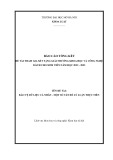
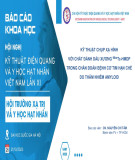

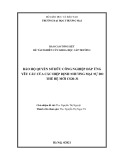
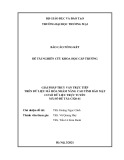

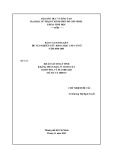
![Vaccine và ứng dụng: Bài tiểu luận [chuẩn SEO]](https://cdn.tailieu.vn/images/document/thumbnail/2016/20160519/3008140018/135x160/652005293.jpg)

